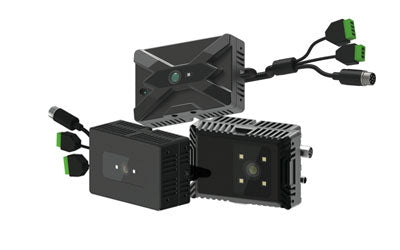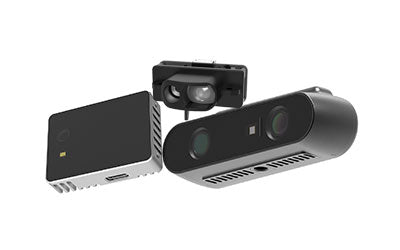Semiconductor Chips & ToF Tech: Shaping the Future of Smart Vision
- por TofSensor
What is a Semiconductor Chip?
A semiconductor chip is a miniature electronic component made from semiconductor materials (usually silicon) that performs various computational and control tasks. Semiconductor chips are the core components of modern electronic devices and are widely used in computers, smartphones, home appliances, automobiles, communication devices, and other areas.
The working principle of semiconductor chips is based on the conductive properties of semiconductor materials, which can control the flow of electrons to perform functions such as switching, amplification, rectification, and signal processing. A chip typically contains multiple integrated circuits (ICs) that work together to perform various functions.
The manufacturing process of semiconductor chips involves complex microelectronics techniques, such as photolithography, etching, and doping, usually requiring a clean room environment. As technology progresses, the size of semiconductor chips has become smaller, their functionality more powerful, and they have made significant advancements in processing speed and energy efficiency.
With the rapid development of semiconductor technology, the combination of ToF (Time-of-Flight) technology and semiconductor chips is revolutionizing fields such as smart vision, robotics, autonomous driving, and the Internet of Things (IoT). ToF sensors, through accurate distance measurement and depth sensing, are driving the proliferation of various smart devices, with semiconductor chips playing a critical role by providing efficient data processing and computational power for ToF technology.
What is ToF Technology?
ToF (Time-of-Flight) technology is a method that measures the time it takes for a light pulse to travel from the sensor to an object's surface and back. By calculating the time difference, ToF sensors can precisely determine the distance between the object and the sensor, creating high-quality depth images or 3D point cloud data. ToF technology is widely used in fields such as autonomous driving, robotic navigation, augmented reality (AR), and virtual reality (VR), offering high-precision spatial awareness.
The Integration of Semiconductor Chips and ToF Technology
Semiconductor chips play a crucial role in the application of ToF technology, especially in advancing smart vision and depth sensing technologies. ToF sensors calculate the distance between an object and the sensor by measuring the time it takes for the light pulse to travel from emission to reflection. This process requires processing large amounts of measurement data and performing complex calculations. Semiconductor chips, as the core hardware of ToF sensors, are responsible for processing this data at high speeds and efficiently converting light signals into precise depth information, providing real-time environmental feedback.
With the continuous advancement of semiconductor technology, the computational power, processing speed, and energy efficiency of chips have significantly improved, further driving the application of ToF technology in various fields. For example, chips using advanced semiconductor materials (such as Gallium Nitride (GaN), silicon photonics, etc.) and manufacturing processes can support higher-precision depth sensing and handle more data points, ensuring efficient and stable depth measurement in complex and dynamic environments. Additionally, the integration of semiconductor chips has increased, enabling the simultaneous handling of multiple tasks such as signal amplification, noise suppression, and data analysis, thereby improving the overall performance of ToF sensors.
More powerful computational capabilities mean that ToF technology can excel not only in traditional applications such as 3D imaging, autonomous driving, and robotic navigation but also in more complex scenarios, such as precise measurements in low-light or high-dynamic-range environments, detailed object tracking, and complex environmental awareness. By integrating semiconductor chips with ToF technology, smart devices can achieve efficient and accurate depth sensing across more application scenarios, accelerating the development of emerging fields such as IoT, AR, and VR.
Advantages of Semiconductor Chips in ToF Sensors
-
High Processing Speed: Modern semiconductor chips feature extremely high data processing speeds, enabling them to quickly analyze the reflection time of light pulses and calculate the distance to objects in real-time. This is crucial for applications requiring fast responses, such as autonomous driving and robotic navigation.
-
Low Power Consumption: The low power consumption of semiconductor chips allows ToF sensors to operate for extended periods while maintaining minimal energy use. This makes ToF sensors suitable for applications in wearable devices, smartphones, and IoT devices, enhancing device battery life.
-
Miniaturization and Integration: As semiconductor technology continues to progress, ToF sensors and their associated computational chips are becoming smaller and more integrated. This not only reduces production costs but also enables ToF sensors to be incorporated into various portable devices, such as smartphones, drones, and AR glasses.
-
High Precision and Stability: Semiconductor chips offer high-precision data processing, ensuring that ToF sensors perform stably in complex environments. In low-light conditions or scenes with a high dynamic range, ToF sensors can provide more accurate depth data through optimized algorithms from the semiconductor chips.
Application Scenarios of Semiconductor Chips and ToF Technology
The integration of semiconductor chips and ToF technology demonstrates immense potential in various fields:
-
Autonomous Driving: In autonomous vehicles, ToF sensors, supported by semiconductor chips, can detect surrounding obstacles, pedestrians, and traffic signs in real-time. The accurate depth-sensing capability improves the safety of the autonomous system, helping vehicles respond quickly and accurately.
-
Robotic Navigation: The combination of ToF sensors and semiconductor chips enables robots to navigate and avoid obstacles in complex environments. Robots can use ToF sensors to create 3D maps of their surroundings, performing efficient path planning and task execution.
-
Augmented Reality (AR) and Virtual Reality (VR): The depth information provided by ToF sensors enhances the AR/VR experience, allowing virtual objects to seamlessly blend with the real world. Semiconductor chips play a critical role in this process by ensuring high-speed processing and low-latency responses, improving user interaction and immersion.
-
Internet of Things (IoT) Devices: With the miniaturization and integration of ToF sensors, more IoT devices are adopting ToF technology for spatial awareness. For example, smart home applications such as object detection and smart surveillance systems can leverage ToF technology for more intelligent environmental sensing.
-
Medical Imaging: In medical imaging, ToF technology can provide high-precision 3D images, assisting doctors in diagnosing diseases more effectively. The high-performance and low-power characteristics of semiconductor chips make this technology suitable for use in portable medical devices.
Future Outlook: Innovations in Semiconductor Chips and ToF Technology
As semiconductor technology continues to evolve and ToF technology matures, the integration of both will foster more innovative applications. In the future, as chip computing power increases and manufacturing processes improve, ToF sensors will become more efficient, precise, and cost-effective.
-
Higher Precision Depth Sensing: Future semiconductor chips will better support higher-precision ToF sensors, providing more detailed spatial awareness data. This will drive the development of autonomous driving, robotics, AR/VR, and other fields, making these technologies smarter and more precise.
-
Wider Application Scenarios: With the miniaturization and integration of ToF technology and semiconductor chips, ToF sensors will find their way into more consumer products, such as smartphones, wearables, and smart home devices, enhancing the intelligence of these devices.
-
Low Power Consumption and Long Battery Life: Future semiconductor chips will further optimize power consumption, allowing ToF sensors to provide depth sensing for extended periods in low-power environments. This will help promote the adoption of ToF technology in more mobile devices.
Conclusion
The combination of semiconductor chips and ToF technology is accelerating the widespread adoption and application of smart vision, depth sensing, and spatial positioning technologies. Whether in autonomous driving, robotics, augmented reality, or IoT, the synergy between the two will drive industries towards greater intelligence, automation, and precision. With continuous advancements in semiconductor technology and ToF sensors, future smart devices will become more efficient, precise, and user-friendly, offering richer and more immersive user experiences.
Synexens 3D Of RGBD ToF Depth Sensor_CS30

Our professional technical team specializing in 3D camera ranging is ready to assist you at any time. Whether you encounter any issues with your TOF camera after purchase or need clarification on TOF technology, feel free to contact us anytime. We are committed to providing high-quality technical after-sales service and user experience, ensuring your peace of mind in both shopping and using our products.
-
Postado em
CS30


